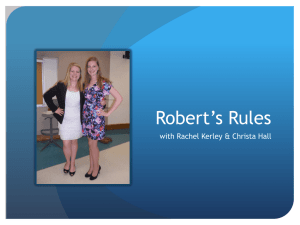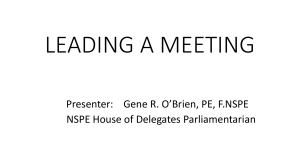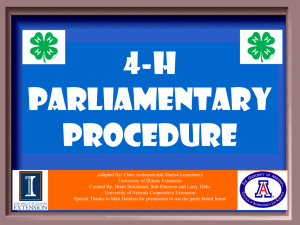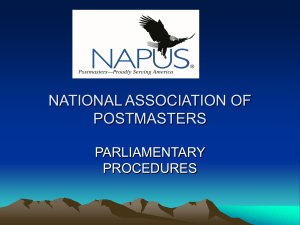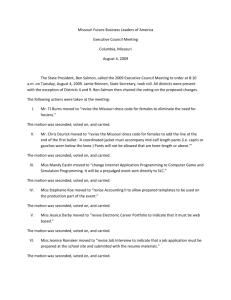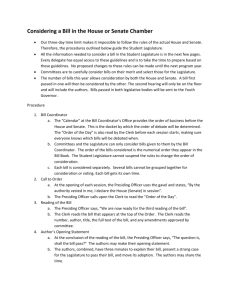STRUCTURED MEETINGS - Altrusa International
advertisement
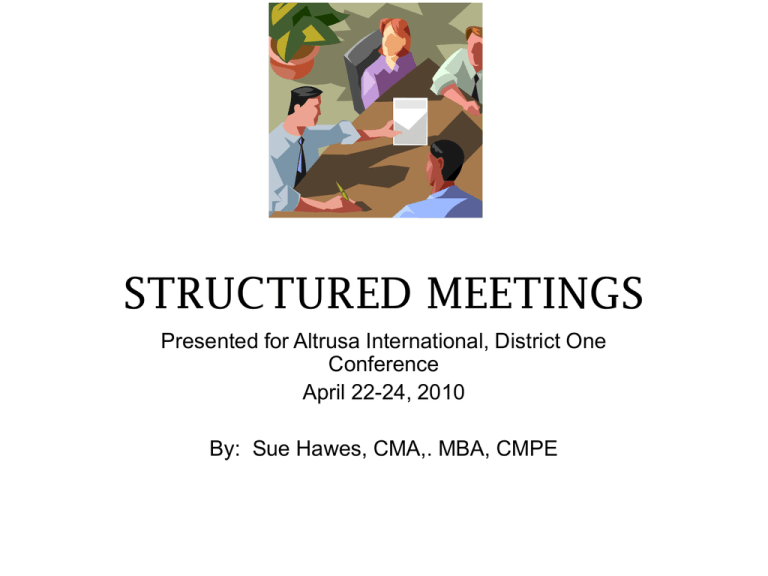
STRUCTURED MEETINGS Presented for Altrusa International, District One Conference April 22-24, 2010 By: Sue Hawes, CMA,. MBA, CMPE OBJECTIVES • • • • Define the criteria for an effective meeting. List five types of meetings. What is the Role of the Presiding Officer. List the five P’s of the Presiding Officer. OBJECTIVES CONTINUED • • • • • Moans and Groans. Responsibilities of meeting members. Good meeting components. Function/importance of meetings. Meeting Development. EFFECTIVE MEETINGS • Formal agenda. • Roles and responsibilities of attendees should be clearly defined. • Parliamentary procedure should be used. • Meeting flow should be steady. • At all times, individuals should be respected. TYPES OF MEETINGS • • • • • Feedback Planning Reporting Decision Making Problem Solving ROLE OF PRESIDING OFFICER Prepares for the meeting. Keeps the meeting on track until the agenda has been fulfilled. The presiding officer is always neutral, allows for both sides of an issues to be heard, and always protects members from personal attack. The presiding officer always remains within the time constraints. THE PRESIDING OFFICER SHALL • • • • • PREPARE PRESIDE PREVENT PROTECT PROCLAIM CRITERIA OF GOOD MEETINGS • • • • • Presiding Officer should show Leadership. Meeting should be structured. Preplanning Preparation Timing MOANS AND GROANS • • • • • • Meetings that do not start on time. Unprepared Presiding Officer. Meeting not Orderly. Dominated by Members. Waste of Time/Gripe Session. Nothing Accomplished. MEMBER RESPONSIBILITIES • • • • • • • Give Speaker your full attention. Stay Focused. Always Keep an Open Mind. Leave Negative Attitudes at the Door. LISTEN! Participation not Domination. Commit to Actions Adopted. HOW DID THE MEETING GO? • • • • • • Did the group work together? Was the meeting fun? Was business handled in a timely manner? Was the meeting orderly? Were problems solved? Did attendees draw and build on each others ideas? FUNCTION AND IMPORTANCE OF MEETINGS • Effective way to accomplish tasks. • Effective way of communicating information to others. • Produces way to achieve results in your objectives. • Allows input of knowledge and expertise of many. MEETING MINUTES CONTAIN • • • • • Kind of Meeting – Regular, Special Organization, Date, Time, Place Those in Attendance-Officers Reports Given Motions made and Disposition of those motions. • Time Adjournment/Signature of Secretary MEETING DEVELOPMENT • Request Agenda Items from appropriate departments or staff. • Develop and Finalize Agenda with all pertinent parties. • Know in advance who is responsible for each item on the agenda. • Watch the time constraints. • Stick to the Agenda. MOTIONS • Motions are used in Parliamentary Procedure to bring a topic up for discussion. • Motions require a second, the item is than up for discussion, after discussion is closed the presiding officer calls for the vote. • The presiding officer will ask all in favor as well as all opposed. Announces carried or defeated, move to next item of business. SAMPLE MOTIONS • • • • • • To Reconsider. To Amend. To Postpone to a Date Certain. To Postpone Indefinitely. Motion to Table. Motion to Suspend the Rules. MOTION TO RECONSIDER • This motion is used when a member wishes to have the vote reconsidered. This requires a majority of the voting body to pass. Once passed the original voted question is again brought to a vote. MOTION TO AMEND • When an item of business has been moved and seconded, there can be a motion to amend that order, once it is seconded, there would be a vote. There would be allowed discussion. Once voted, if passed than a member would move passage of the order as amended. • The motion can not be amended, but can be debated if the original item is debatable. MOTION TO POSTPONE TO A DATE CERTAIN • A member would move and item of business, there would be a second. There would than be a motion to postpone to a specific date, there would be a second, than a vote. This motion can be amended and can be debated. MOTION TO POSTPONE INDEFINITELY • A member would move an item of business, there would be a second. A member would move to postpone the item indefinitely, there would be a second. The item would be voted. This motion can be amended and debated. MOTION TO TABLE A member would move the item of business, there would be a second. A motion could be made to table this item, there would be a second and a vote. The motion can not be debated or amended. MOTION TO SUSPEND THE RULES • This motion is used to take action on an item of business out of the usual order of business. This can not be debated or amended. • This motion would be moved, seconded and so voted. This can be a vote unless doubted in lieu of a roll call vote. • Assuming passage there would be a motion to pass the item of business in question, seconded and so voted after discussion. THANK YOU • Thank you for your attention. It has been my pleasure to be with you today.
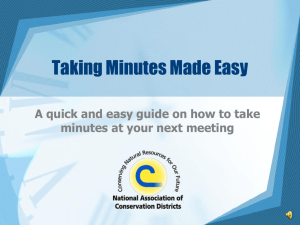
![Minutes Template [] - Charles Sturt University](http://s3.studylib.net/store/data/007868767_2-bdad87995ff934498ecd81ee6a2daa55-300x300.png)
